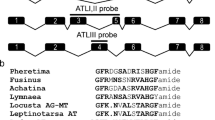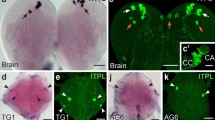Summary
-
1.
A 28-kDa peptide from the brain of the tobacco hornworm,Manduca sexta, was purifiedvia HPLC. The peptide copurified with the insect neurohormone, prothoracicotropic hormone (PTTH), through two HPLC columns.
-
2.
Immunocyctochemistry using polyclonal antibodies against the 28-kDa peptide revealed that the peptide was produced in the same protocerebral neurons that produce PTTH. Western blot analysis demonstrated that the 28-kDa peptide and big PTTH are different molecules.
-
3.
A PTTHin vitro bioassay indicated that despite having chromatographic properties similar to those of big PTTH and being produced by the same neurons, the 28-kDa peptide did not have PTTH activity.
-
4.
Amino acid sequence analysis yielded a 27 N-terminal amino acid sequence that had no similarity with known peptides.
-
5.
Immunocytochemical studies revealed that the 28-kDa peptide is present as early as 30% embryonic development and is absent by adult eclosion. This is in contrast to big PTTH, which is expressed throughout theManduca life cycle.
-
6.
These data suggest that the 28-kDa peptide is another secretory phenotype of the lateral neurosecretory cell group III (L-NSC III) which may have functions distinct from those for big PTTH or may act synergistically with big PTTH.
Similar content being viewed by others
References
Agui, N., Westbrook, A. L., McQueen, C. T., Flanagan, T. R., and Bollenbacher, W. E. (1989). Regeneration of the neurohemal terminals for identified cerebral neurosecretory cells in the insect.J. Comp. Neurol. 289337–347.
Bartfai, T., Iverfeldt, K., Fisone, G., and Serfozo, P. (1988). Regulation of the release of coexisting neurotransmitters.Annu. Rev. Pharmacol. Toxicol. 28285–310.
Bell, R. A., and Joachim, F. G. (1976). Techniques for rearing laboratory colonies of tobacco hornworms and pink bollworms.Ann. Entomol. Soc. Am. 69365–373.
Blum, H., Beier, H., and Gross, H. J. (1897). Improved silver staining of plant proteins, RNA and DNA in polyacrylamide gels.Electrophoresis 893–99.
Bollenbacher, W. E., and Gilbert, L. I. (1981). Neuroendocrine control of postembryonic development in insects: The prothoracicotropic hormone. InNeurosecretion: Molecules, Cells, Systems (D. S. Farner and K. Lederis, Eds.), Plenum Press, New York, pp. 361–379.
Bollenbacher, W. E., Agui, N., Granger, N. A., and Gilbert, L. I. (1979).In vitro activation of insect prothoracic glands by the prothoracicotropic hormone.Proc. Natl. Acad. Sci. USA 765148–5152.
Bollenbacher, W. E., and Granger, N. A. (1985). Endocrinology of the prothoracicotropic hormone. InComprehensive Insect Physiology Biochemistry and Pharmacology, Vol. 7 (G. A. Kerkut and L. I. Gilbert, Eds.), Pergamon Press, Oxford, pp. 109–151.
Bollenbacher, W. E., O'Brien, M. A., Katahira, E. J., and Gilbert, L. I. (1983) A kinetic analysis of the action of the insect prothoracicotropic hormone.Mol. Cell. Endocrinol. 3227–46.
Bollenbacher, W. E., Katahira, E. J., O'Brien, M. A., Gilbert, L. I., Thomas, M. K., Agui, N., and Baumhover, A. H. (1984). Insect prothoracicotropic hormone: Evidence for two molecular forms.Science 2241243–1245.
Bondy, C. A., Whitnall, M. H., Brady, L. S., and Gainer, H. (1989). Coexisting peptides in hypothalmic neuroendocrine systems: Some functional implications.Cell. Mol. Neurobiol. 9427–446.
Brain, S. D., and Williams, T. J. (1988). Substance P regulates the vasodilatory activity of calcitonin gene-related peptide.Nature 33573–75.
Chan-Palay, V. (1987). Somatostatin immunoreactive neurons in the human hippocampus and cortex shown by immunogold/silver intensification on vibratome sections: Coexistence with neuropeptide Y neurons, and effects in Alzheimer-type dementia.J. Comp. Neurol. 238382–389.
Chronwall, B. M., Chase, T. N., and O'Donohue, T. L. (1984). Coexistence of neuropeptide Y and somatostatin in rat and human cortical and rat hypothalmic neurons.Neurosci. Lett. 52213–217.
Davila, J.-C., De La Calle, A., Guitierrez, A., Megias, M., Andreu, M. J., and Guirado, S. (1991). Distribution of neuropeptide Y (NPY) in the cerebral cortex of the lizardsPsammodromus algirus and Podarcis hispanica: Co-localization of NPY, somatostatin, and GABA.J. Comp. Neurol. 308397–408.
Engvall, E., and Perlman, P. (1971). Enzyme-linked immunosorbant assay (ELISA): Quantitative assay of immunoglobulin G.Immunochemistry 8 871–874.
Fisher, J. M., Soussin, W., Newcomb, R., and Scheller, R. H. (1988). Multiple neuropeptides from a common precursor are differentially packaged and transported.Cell 54813–822.
Galfre, G., and Milstein, C. (1981). Preparation of monoclonal antibodies: Strategies and procedures. InMethods in Enzymology, Vol. 73 (J. J. Langone and H. Van Vunakis, Eds.), Academic Press, Orlando, FL, pp. 3–46.
Gibbins, I. L., Furness, J. B., Costa, M., MacIntyre, I., Hillyard, C. J., and Girgis, S. (1985). Co-localization of calcitonin gene-related peptide-like immunoreactivity with substance P in cutaneous vascular and visceral sensory neurons of guinea pigs.Neurosci. Lett. 57125–130.
Gray, R. S. (1992).Multiple peptide expression by the prothoracicotropic hormone producing neurons, the L-NSCIII, in the tobacco hornworm,Manduca sexta. Ph.D. Dissertation, University of North Carolina at Chapel Hill.
Herman, W. S. (1967). The edysial gland of arthropods. InInternational Review of Cytology, Vol. 22 (G. H. Bourne and J. F. Danielli Eds.), Academic Press, New York, pp. 269–347.
Hewes, R. S., and Truman, J. W. (1991). The roles of central and peripheral eclosion hormone release in the control of ecdysis behavior inManduca sexta.J. Comp. Physiol. 168697–707.
Kataoka, H., Nagasawa, H., Kawakami, A., Oka, T., Mizoguchi, A., Iwami, M., Ishizaki, H., and Suzuki, A. (1991).Bombyx prothoracicotropic hormone. In,Insect Neuropeptides, Chemistry, Biology, and Action (J. Menn, T. J. Kelly and P. E. Masler, Eds.), ACS, Washington, DC, pp. 20–26.
Kawakami, A., Kataoka, H., Oka, T., Mizoguchi, A., Kimura-Kawakami, M., Adachi, T., Iwami, M., Nagasawa, H., Suzuki, A., and Ishizaki, H. (1990). Molecular cloning of theBombyx mori prothoracicotropic hormone.Science 2461333–1335.
Kohler, G., and Milstein, C. (1975). Continuous cultures of fused cells secreting antibody of predefining specificity.Nature 256495–497.
Laemmli, U. K. (1970). Cleavage of structural proteins during the assembly of the head of bacteriophage T4.Nature 227680–685.
Lundberg, J. M., Franco-Cereceda, A., Hua, X., Hokfelt, T., and Fischer, J. A. (1985). Co-existence of substance P and calcitonin gene-related peptide-like immunoreactivities in sensory nerves in relation to cardiovascular and bronchoconstrictor effects of capsaicin.Eur. J. Pharmacol. 108315–319.
Muehleisen, D. P., Gray, R. S., Katahira, E. J., and Bollenbacher, W. E. (1993) Immunoaffinity purification of a cerebral prothoracicotropic peptide fromManduca sexta Peptides (in press).
Mulle, C., Benoit, P., Pinset, C., Roa., M., and Changeux, J.-P. (1988). Calcitonin gene-related peptide enhances the rate of desensitization of the nicotinic acetylcholine receptor in cultured mouse muscle cells.Proc. Natl. Acad. Sci. 855728–5732.
New, H. V., and Mudge, A. W. (1986). Calcitonin gene-related peptide regulates muscle acetylcholine receptor synthesis.Nature 323809–811.
Newcomb, R., Fisher, J. M., and Scheller, R. H. (1988). Processing of the egg-laying hormone (ELH) precursor in the bag cell neurons ofAplysia.J. Biol. Chem. 26312514–12521.
O'Brien, M. A., Katahira, E. J., Flanagan, T. R., Arnold, L. W., Haughton, G., and Bollenbacher, W. E. (1988). A monoclonal antibody to the insect prothoracicotropic hormone.J. Neurosci. 83247–3257.
Roberts, J. L., Lundblad, J. R., Ebetrwine, J. H., Fremeau, R. T., Salton, S. R., and Blum, M. (1987). Hormonal regulation of POMC gene expression in pituitary.Ann. N. Y. Acad. Sci. 512275–285.
Rosenfeld, M. G., Mermod, J. J., Amara, S. G., Swanson, L. W., Rivier, J., Vale, W. W., and Evans, R. M. (1983). Production of a novel neuropeptide encoded by the calcitonin gene via tissue-specific RNA processing.Nature 304129–135.
Scheller, R. H., Jackson, J. F., McAllister, L. B., Rothman, B. S., Mayeri, E., and Axel, R. (1983). A single cell encodes multiple peptides mediating a stereotyped behavior.Cell 327–22.
Schotzinger, R. J., and Landis, S. (1988). Cholinergic phenotype developed by noradrenergic sympathetic neurons after innervation of a novel cholinergic targetin vivo.Nature 335637–639.
Sossin, W. S., and Scheller, R. H. (1989). A bag cell neuron-specific antigen localizes to a subset of dense core vesicles inAplysia californica.Brain Res. 494205–214.
Sossin, W. S., Sweet-Cordero, A., and Scheller, R. H. (1990). Dale's hypothesis revisited: Different neuropeptides derived from a common prohormone are targeted to different processes.Proc. Natl. Acad. Sci. USA 874845–4848.
Towbin, H. T., Staehelin, T., and Gordon, J. (1979). Electrophoretic transfer of proteins from polyacrylamide gels to nitrocellulose sheets: Procedure and some applications.Proc. Natl. Acad. Sci. USA 764350–4354.
Truman, J. W., and Copenhaver, P. F. (1989). The larval eclosion hormone neurons inManduca sexta: Identification of the brain-proctodeal neurosecretory system.J. Exp. Biol. 147457–470.
Tublitz, N. J., and Slywester, A. W. (1990). Postembryonic alteration of transmitter phenotype in individually identified peptidergic neurons.J. Neurosci. 10161–168.
Warren, J. T., Sakurai, S., Rountree, D. B., Gilbert, L. I., Lee, S.-S., and Nakanishi, K. (1988). Regulation of the ecdysteroid titer ofManduca sexta: Reappraisal of the role of the prothoracic glands.Proc. Natl. Acad. Sci. USA 85958–962.
Westbrook, A. L., and Bollenbacher, W. E. (1990). The development of identified neurosecretory cells in the tobacco hornworm,Manduca sexta.Dev. Biol. 140291–299.
Westbrook, A. L., Regan, S. A., and Bollenbacher, W. E. (1993). Developmental expression of the prothoracicotropic hormone in the CNS of the tobacco hornworm,Manduca sexta J. Comp. Neurol. (in press).
Author information
Authors and Affiliations
Rights and permissions
About this article
Cite this article
Gray, R.S., Muehleisen, D.P., Katahira, E.J. et al. A 28-kDa cerebral neuropeptide fromManduca sexta: Relationship to the insect prothoracicotropic hormone. Cell Mol Neurobiol 13, 39–58 (1993). https://doi.org/10.1007/BF00712988
Received:
Accepted:
Issue Date:
DOI: https://doi.org/10.1007/BF00712988




